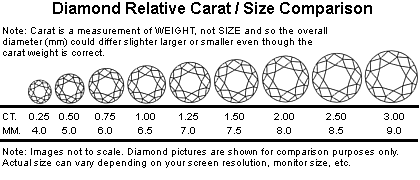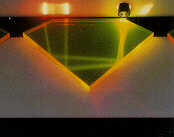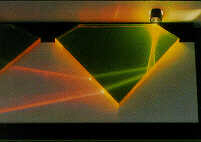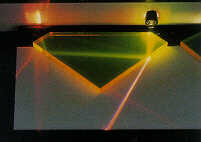GEMS
Carat weight is the weight of the diamond measured in carats. One carat is divided into 100 "points," so that a diamond of 75 points weighs 0.75 carats. Carat weight is the most obvious factor in determining the value of a diamond. But two diamonds of equal carat weights can have very different prices, depending on their quality. Diamonds of high quality can be found in all size ranges.

Since diamonds are measured by carat weight, and not size, two diamonds of the same weight could have different sizes. Why? If a diamond is cut too shallow (or flat) it will have a larger diameter, but shallow depth and appear larger. Likewise, if a diamond is cut too deep (or pointed) it will have a smaller diameter and deep depth and appear smaller. This is why cut is so important. You want to make sure the diamond is cut to proper proportions. Not only does it make a large difference in the diamond's ability to reflect light, but a poorly cut diamond will not be proportionate in size to a diamond cut to proper specifications. For example, let's say you're interested in a 1.00ct diamond solitaire with a table of only 49%, the diamond will be cut way too steep and will look like a 0.80ct diamond instead.
Diamond Clarity is a measure of a diamond's internal flaws and impurities. A diamond that is virtually free of interior or exterior inclusions (commonly reffered to as flaws) is of the highest quality, for nothing interferes with the passage of light through the diamond. To determine a diamond's clarity, it is viewed under 10x magnification by a trained gemologist. Small inclusions neither mar its beauty nor endanger its durability.

Flawless - No internal or external flaws.
Internally Flawless - No internal flaws. Very rare and beautiful diamonds which are quite expensive.
VVS1, VVS2 - Very, Very Slightly Included: Very difficult to see inclusions under 10x magnification. An excellent quality diamond.
VS1, VS2 - Very Slightly Included: Inclusions are not visible to the unaided eye. Less expensive than the VVS1 or VVS2 grades.
SI1, SI2 - Slightly Included: Inclusions are visible under 10x magnification, SI clarity diamonds are usually of the best value since inclusions are not visible to the naked eye and prices are reasonable when compared to prices of the VS2 clarity and up grades.
SI3 - Slightly Included-EGL: SI3 is an EGL grade and is not recognized by GIA or other gemological institutions. It may be graded by GIA as either SI2 or I1. SI3 diamonds never have any black inclusions or cracks visible to the naked eye, but may have some very minor white inclusions which can be seen with the naked eye.
I1 - Included: an I1 clarity diamond will have a visible flaw which can be seen with the naked eye, but there should only be one major flaw which is not too obvious. If your budget only allows for an SI3 or I1 clarity diamond, be sure to examine it thouroughly before purchasing and make sure you can not see any inclusions.
I2, I3 - Included: These diamonds will have inclusions visible to the naked eye, and will have many black spots from the black inclusions and appear cloudy from the white inclusions, feathers and cracks.
Diamond ColourThe diamond color grading scale varies from totally colorless to light yellow. The differences between one diamond color grade and another are very subtle and difficult to distinguish.

D-F : Colorless: perfect or almost perfect color.
G-J : Near colorless: good to very good color, and this diamond may "face up" colorless when mounted, especially in white gold or platinum.
K-M : Light but noticeable yellow or brown tint. Not recommended for larger diamond stone purchases, especially in engagement rings.
Out of the 4 C's, color and cut are the two most important characteristics of a diamond. Do not compromise on color. An "H" color or better is usually best.
Diamond
Cut
Many people confuse diamond cut with the shape
of a diamond. Most diamonds are cut round with
a full 58 facets, and a good cut, or make, has
more scintillation, more sparkle. Although the
cut of the diamond may affect the value of the
diamond, the shape, is largely a matter of personal
preference and does not affect the value significantly.
It is the work of a master cutter that allows
the diamond to be cut in such a way as to permit
the maximum amount of light to be reflected
through the diamond, and that's a great reflection
on you. It is the cut that enables a diamond
to make the best use of light. For more about
the cut of our diamonds, please see the next
section below.
1. When a diamond is cut to good proportions, light is reflected from one facet to another and then dispersed through the top of the stone.

2. If the cut of the diamond is too deep, some
light escapes through the opposite side of the
pavilion.

3.
If the cut is too shallow, light escapes through
the pavilion before it can be reflected.

Daimond
Shapes
Diamonds come in a variety of shapes. Do
not confuse cut with shape, cut is what determines
how well-cut your diamond is, where as diamond
shape is the shape it was cut into.
 |
Round Brilliant - Do not confuse with round. The round brilliant is the modern version of the round which has been refined for maximum shine. The round brilliant is by far the most popular and has the best angles for which to shine maximum brilliance. |
 |
Oval - Not as popular for solitaires, but very popular for three stone anniversary rings, with two matching diamonds on the sides. |
 |
Princess - A square cut diamond that has refractive properties almost near round brilliant. The princess is the preferred square cut shape over radiant. |
 |
Emerald - A more traditional shape, the emerald is not as popular as it used as it once was, but has an old world elegance to it. |
 |
Radiant - Popular before the princess shape was around, the radiant has more facets than a princess, but has the corners trimmed like the emerald shape. This shape is not widely popular. |
 |
Heart - Hard to find due to low demand, but some people prefer a heart shape diamond for sentimental purposes. |
|
|
Marquise - Like the emerald, the marquise is a traditional shape. This is probably the fourth most popular shape behind the round, princess and oval. |
|
|
Pear - Mostly used in pendants, the pear shape diamond is shaped in a tear drop shape and has fairly good proportions to refract light well. |
Diamond Enhancements
There are a variety of diamond enhancements or treatments a diamond can undergo that can significantly alter the price of the diamond when compared to a natural diamond. The FTC requires all diamond merchants to disclose all diamond enhancements and treatments to their customers. Failure to do so can result in fraudulent charges and lawsuits against the diamond dealer. When buying a diamond, it is recommended to simply ask for a non-treated or enhanced diamond and have the merchant clearly indicate on the invoice somewhere that the diamond is in fact, not treated and 100% natural mined from the earth. Listed below are some treatments that are done with gemstones.
Bleaching: The use of chemicals or other agents to lighten or remove a gemstone's color to achieve a brighter/whiter diamond.
Gamma/Electron Irradiation: The use of gamma and/or electron bombardment to alter a gemstone's color; may be followed by a heating process. Heating: The use of heat in a high temperature sintering furnace to effect desired alteration of color, clarity, and/or phenomena.Infilling/Fracture Filling: The intentional filling of surface breaking cavities or fractures usually with glass, plastic, opticon with hardeners and/or other hardened foreign substances to improve durability, appearance and/or add weight. The foriegn material will have a different index of refraction than diamond, and a trained gemologist can see the light bending within the stone.
Lasering: A laser is used to penetrate a diamond and remove certain black inclusions. Chemicals are then used to further reach and alter inclusions in diamonds.
Oiling/Resin Infusion: The intentional filling of surface cavities of a colorless oil, wax, natural resin, or unhardened man-made material into fissured transparent/translucent gemstones to improve appearance. (i.e., oil, man-made resin, paraffin, etc.)
Irradiation:
The use of neutron bombardment, with the
combination of any other bombardment and/or
heat treatment to alter a gemstone's color.
Conflict Diamonds
What is a conflict diamond?
Conflict
diamonds are diamonds that originate from areas
controlled by forces or factions opposed to
legitimate and internationally recognized governments.
These diamonds are used to fund military action
in opposition to those governments. The diamonds
are sold on the black market and are used to
propagate a bloody war which victimizes many
children. The last thing anyone wants on their
mind when making a diamond purchase is to know
that their diamond possibly helped aid such
a violent and brutal act of aggression.
Fancy colored Diamonds
Some of the most sort after diamonds of today
are the fancy colors such as Pink, Blue, Yellow,
Green, Champagne & Fancy Cognac to name
but a few. These fancy color diamonds come in
varying depth of colour ranging from intense
to very very light. As a rle the more intense
the colour the higher the valued.








